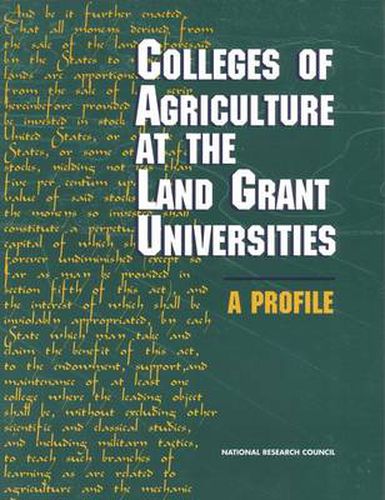Readings Newsletter
Become a Readings Member to make your shopping experience even easier.
Sign in or sign up for free!
You’re not far away from qualifying for FREE standard shipping within Australia
You’ve qualified for FREE standard shipping within Australia
The cart is loading…






Although few Americans work as farmers these days, agriculture on the whole remains economically important - playing a key role in such contemporary issues as consumer health and nutrition, worker safety and animal welfare, and environmental protection. This publication provides a comprehensive picture of the primary education system for the nation’s agriculture industry: the land grant colleges of agriculture. Colleges of Agriculture at the Land Grant Universities informs the public debate about the challenges that will shape the future of these colleges, and serves as a foundation for a second volume, which will present recommendations for policy and institutional changes in the land grant system. This book reviews the legislative history of the land grant system from its establishment in 1862 to the 1994 act conferring land grant status on Native American colleges. It describes trends that have shaped agriculture and agricultural education over the decades - the shift of labour from farm to factory, reasons for and effects of increased productivity and specialization, the rise of the corporate farm, and more. The committee reviews the system’s three-part mission - education, research, and extension service - and through this perspective documents the changing nature of funding, and examines the unique structure of the U.S. agricultural research and education system. Demographic data on faculties, students, extension staff, commodity and funding clusters, and geographic specializations profile the system and identify similarities and differences among the colleges of agriculture, trends in funding, and a host of other issues. The tables in the appendix provide further itemization about general population distribution, student and educator demographics, types of degree programs, and funding allocations. Concise commentary and informative graphics augment the detailed statistical presentations. This book will be important to policymakers, administrators, educators, researchers, and students of agriculture.
$9.00 standard shipping within Australia
FREE standard shipping within Australia for orders over $100.00
Express & International shipping calculated at checkout
Although few Americans work as farmers these days, agriculture on the whole remains economically important - playing a key role in such contemporary issues as consumer health and nutrition, worker safety and animal welfare, and environmental protection. This publication provides a comprehensive picture of the primary education system for the nation’s agriculture industry: the land grant colleges of agriculture. Colleges of Agriculture at the Land Grant Universities informs the public debate about the challenges that will shape the future of these colleges, and serves as a foundation for a second volume, which will present recommendations for policy and institutional changes in the land grant system. This book reviews the legislative history of the land grant system from its establishment in 1862 to the 1994 act conferring land grant status on Native American colleges. It describes trends that have shaped agriculture and agricultural education over the decades - the shift of labour from farm to factory, reasons for and effects of increased productivity and specialization, the rise of the corporate farm, and more. The committee reviews the system’s three-part mission - education, research, and extension service - and through this perspective documents the changing nature of funding, and examines the unique structure of the U.S. agricultural research and education system. Demographic data on faculties, students, extension staff, commodity and funding clusters, and geographic specializations profile the system and identify similarities and differences among the colleges of agriculture, trends in funding, and a host of other issues. The tables in the appendix provide further itemization about general population distribution, student and educator demographics, types of degree programs, and funding allocations. Concise commentary and informative graphics augment the detailed statistical presentations. This book will be important to policymakers, administrators, educators, researchers, and students of agriculture.